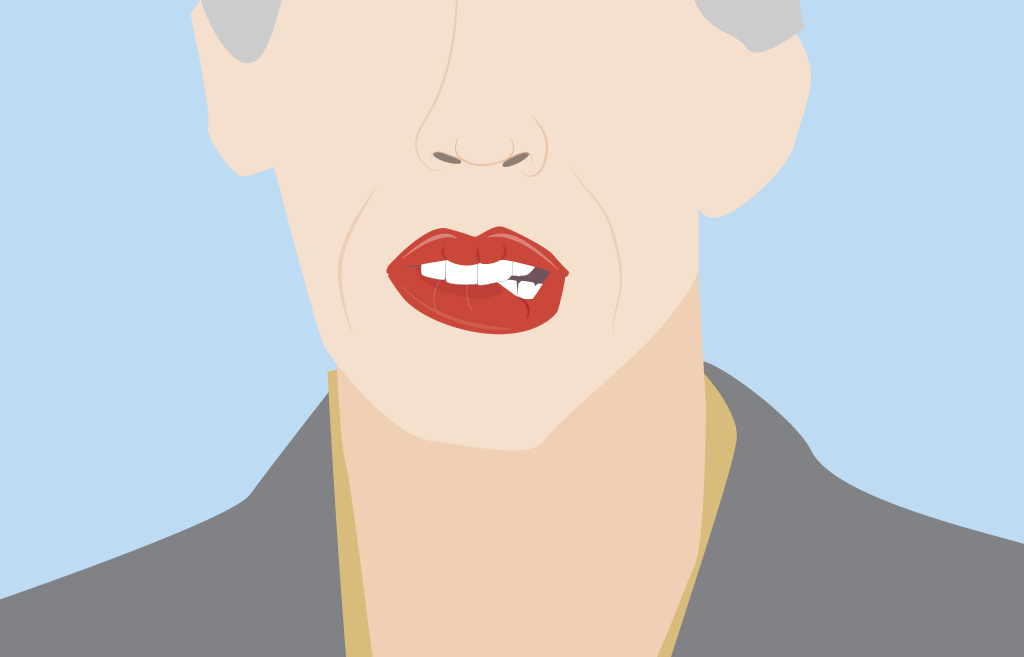
Lip-cheek biting—also referred to as cavitadaxia (Moritz et al., 2020)—is included under the overarching category of “body-focused repetitive disorders” (BFRBs; APA, 2013). This behavior includes repetitive biting, chewing, or nibbling of the oral mucosa, lips, and/or tongue. Cavitadaxia literally means “oral cavity biting.”
Cheek biting typically becomes evident in the area of the middle, inner cheek. Often, many individuals do not consciously realize that they are biting their lip or cheek. For lip-cheek biting, dental splints have been proven to be especially effective (see Helpful Things) as well as the decoupling method (see Self-Help Techniques and Videos; Moritz et al., 2020).
Age of onset
The mean age of onset is approximately 15 years (Moritz et al., 2023).
Prevalence
About one-third of the population occasionally bites their lips, cheeks, and oral mucosa; the criteria for the disorder are met by about 3.2 percent (Houghton et al., 2018). Considering cases with severe damage, such as injured tissue on the inside of the mouth, close to 8 percent of the population is affected at least once during their lifetime (Moritz et al., 2024).
Childhood
The prevalence of lip-cheek biting in children aged 2 to 17 years is approximately 1.9 percent (Shulman, 2005). In up to 9 percent of children, lesions on the inside of the cheek can be found that indicate cavitadaxia (Owczarek-Drabińska et al., 2022).
Adolescence and adulthood
Approximately 1 to 7 percent of adolescents are affected by lip-cheek biting (Sarkhel et al., 2011; Shetty & Munshi, 1998). The behavior occurs in approximately 3.2 to 5.7 percent of the population aged 18 years or older (Houghton et al., 2018; Teng et al., 2002). Over the course of their lives, 7.9 percent of the general population has been affected at least once by lip-cheek biting with visible consequences (Moritz et al., 2024). If milder cases without visible consequences are included, as many as 75 percent report having performed this behavior at least once.
Manifestation
Lip biting
Repeated biting of the lip can lead to various complications: redness, painful sores, and tears in the mucosa and on the lip or inner lining of the mouth. Lip biting can cause injuries and, in the long run, may also damage the thin, sensitive skin on the lips, causing the lips to become cracked.
Cheek biting
The consequences of cheek biting include ulcers, sores, and infections of the oral tissues as well as the development of keratosis (keratinization of the top layer of skin). For some people, the cheek mucosa may feel irregular after repeated biting, which in turn increases the urge to keep biting to create a smooth surface.
Consequences
Feelings of guilt and shame, as well as feeling of hopelessness, often accompany the condition.
Literature
American Psychiatric Association. (2013). Diagnostic and statistical manual of mental disorders (5th ed.). https://doi.org/10.1176/appi.books.9780890425596
Houghton, D. C., Alexander, J. R., Bauer, C. C., & Woods, D. W. (2018). Body-focused repetitive behaviors: More prevalent than once thought? Psychiatry Research, 270, 389–393. https://doi.org/10.1016/j.psychres.2018.10.002
Moritz, S., Müller, K., & Schmotz, S. (2020). Escaping the mouth-trap: Recovery from long-term pathological lip/cheek biting (morsicatio buccarum, cavitadaxia) using decoupling. Journal of Obsessive-Compulsive and Related Disorders, 25, 100530. https://doi.org/10.1016/j.jocrd.2020.100530
Moritz, S., Penney, D., Mißmann, F., Snorrason, I. & Schmotz, S. (2023). Same but different? Phenomenological differences among various types of body-focused repetitive behaviors. Annals of Clinical Psychiatry, 35(4). https://doi.org/10.12788/acp.0123
Moritz, S., Scheunemann, J., Jelinek, L., Penney, D., Schmotz, S., Hoyer, L., Grudzień, D. & Aleksandrowicz, A. (2024). Prevalence of body-focused repetitive behaviors in a diverse population sample – rates across age, gender, race and education. Psychological Medicine, 54(8), 1552–1558. https://doi.org/10.1017/S0033291723003392
Owczarek-Drabińska, J. E., Nowak, P., Zimoląg-Dydak, M. & Radwan-Oczko, M. (2022). The prevalence of oral mucosa lesions in pediatric patients. International Journal Of Environmental Research And Public Health/International Journal Of Environmental Research And Public Health, 19(18), 11277. https://doi.org/10.3390/ijerph191811277
Sarkhel, S., Praharaj, S. K., & Akhtar, S. (2011). Cheek-biting disorder: another stereotypic movement disorder?. Journal of Anxiety Disorders, 25(8), 1085–1086. https://doi.org/10.1016/j.janxdis.2011.07.006
Shetty, S. R., & Munshi, A. K. (1998). Oral habits in children – a prevalence study. Journal of the Indian Society of Pedodontics and Preventive Dentistry, 16(2), 61–66.
Shulman, J. D. (2005). Prevalence of oral mucosal lesions in children and youths in the USA. International Journal of Paediatric Dentistry, 15(2), 89–97. https://doi.org/10.1111/j.1365-263x.2005.00632.x
Teng, E. J., Woods, D. W., Twohig, M. P., & Marcks, B. A. (2002). Body-focused repetitive behavior problems: Prevalence in a nonreferred population and differences in perceived somatic activity. Behavior Modification, 26(3), 340–360. https://doi.org/10.1177/0145445502026003003